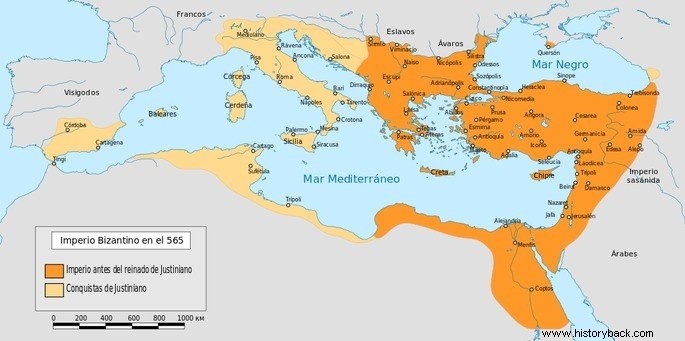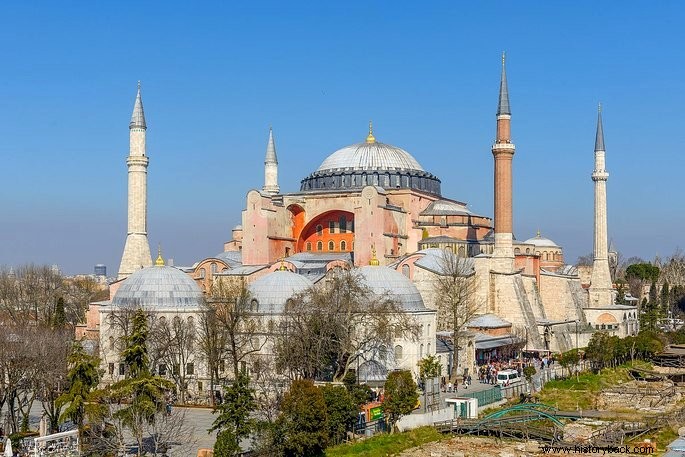The Byzantine Empire It was born from the division of the Roman Empire, in the year 395, into the Eastern Roman Empire, with its capital in Constantinople and the Western Roman Empire, with its capital in Milan.
The city of Constantinople, formerly called Byzantium, had been renamed by Emperor Constantine in the year 330. Today, the city is called Istanbul.
For this reason, the Eastern Roman Empire went down in history as the “Byzantine Empire”. Its territorial extent comprised the Balkan Peninsula, Asia Minor, Syria, Palestine, northern Mesopotamia and northeast Asia
While in the West, the Roman Empire disappeared due to the invasions of different peoples, the Byzantine Empire managed to maintain its unity and its inhabitants called themselves Romans.
With the fall of Rome in 476, the Byzantine Empire became the heir of Roman traditions and survived another thousand years.
Justinian's Government
One of the main Byzantine emperors was Justinian (527-565), for under him, the Byzantine Empire reached its maximum splendor.
The son of peasants, Justinian came to the throne in 527. His wife, Theodora, also came from humble origins and exerted a decisive influence on the administration of the Empire.
Justinian was also responsible for the reconquest of territories that had previously belonged to the Western Roman Empire, including Rome, southern Spain and North Africa. These regions had been occupied by the Germanic peoples.

In power, Justinian sought to organize the laws of the Empire. He commissioned a commission of jurists to prepare the “Digest”, a kind of law manual aimed at students, which was published in 533.
That same year the "Institutes" were published, with the fundamental principles of Roman Law and the following year he concluded the Code of Justinian.
Justinian's three works were a compilation of Roman laws from the Republic to the Roman Empire. Subsequently, the Codex Justinianus , later called Corpus Juris Civilis (Body of Civil Law).
Emperor Justinian also endowed the capital with great buildings such as the church of Hagia Sophia (Holy Wisdom) and the imperial palace.
Characteristics of the Byzantine Empire
Byzantine Culture
Byzantine culture was a mixture of Roman, Hellenistic and Oriental influences. The city of Constantinople was an important commercial and cultural center, and it was from there that Christianity spread.
They adopted Greek as their official language in the 7th century and maintained constant relations with the Asian peoples.
Painting developed along with Christianity and is characterized by frontality, little importance in portraying the human body and the use of colors to emphasize the figures. The architecture combined the luxury and exuberance of the East.
See also:Byzantine Art
Religion in the Byzantine Empire

Justinian sought to use the Christian religion to unite the eastern and western world. He proceeded with the construction of the church of Santa Sofia (532 to 537), an architectural monument with its enormous central dome, supported by columns that end in richly worked capitals. There the Byzantine emperors were consecrated.
When the Turks took Constantinople in 1453, the four minarets that characterize the mosques were added.
Christianity predominated in the Byzantine Empire, but it developed differently than in the West. While the latter found itself increasingly divided, the Church and the Emperor were united in the East.
Therefore, the Emperor is considered as one of the heads of the Church and this union was called “cesaropapism” (caesar + pope) or “theocracy”.
The Eastern Church used the local language in their services and did not admit three-dimensional images. Already the Church in the West did not recognize the Emperor as a head, used Latin in their ceremonies and venerated sculptures.
For the Byzantines, the images, called icons, should be two-dimensional and this dispute ended up leading them to a movement of destruction known as Iconoclasm. Thus, many works of art were lost until agreement was reached on the relationship of veneration of images.
The questioning of Christian dogmas preached by Rome gave rise to some heresies - doctrinal currents discordant with traditional Christian interpretation.
Cultural differences between East and West and power struggles between the Pope and the Emperor, culminated in the division of the Church in 1054, creating a Western Christendom, headed by the Pope; and an eastern one, headed by a collegiate of bishops and the emperor. This fact was called the Eastern Schism.
From then on, the Eastern Church became known as the Orthodox Catholic Church and was responsible for Christianizing places such as Russia, Bulgaria, the Balkan Peninsula, among others.
See also:Eastern Schism
Economy in the Byzantine Empire
Situated in a privileged position, between Europe and Asia, at the passage from the Sea of Marmara to the Black Sea, Constantinople was a point for traders who circulated between East and West. The city had several manufactures, such as silk, and a developed trade.
Due to economic prosperity, the city was the target of military expeditions by eastern peoples and later, by the Arabs. It was fortified with walls and the Byzantines developed “Greek fire”, a substance that allowed it to burn even in water.
The Fall of the Byzantine Empire
After the height of Justinian rule in the 6th century, the Byzantine Empire no longer expanded its territory. Years of prosperity followed, where the Byzantines developed one of the greatest empires of the Medieval Age.
On the other hand, with the conversion of the Arabs to Islam, in the 19th century, VII, several Muslim monarchs began to attack the borders of the Byzantine Empire and occupy it.
During the Late Middle Ages (10th to 15th centuries), in addition to pressure from peoples and empires on its eastern borders and loss of territories, the Byzantine Empire was the target of the western expansionist resumption. The Fourth Crusade was particularly damaging to Constantinople. Instead of the Crusaders attacking Jerusalem, they preferred to wage war against a Christian empire and even installed the Latin Patriarchate there.
With the expansion of the Ottoman Turks in the 14th century, taking the Balkans and Asia Minor, the empire was reduced to the city of Constantinople.
The economic dominance of Italian cities added to the Byzantine weakening, which came to an end in 1453, when Sultan Mohammed II destroyed the walls of Constantinople with powerful cannons.
The Turks made it their capital, calling it Istanbul, as it is known today.
We have more texts on the subject for you :
- Roman Empire
- Orthodox Church
- Fall of the Roman Empire
- Theocracy
- Arab Empire
